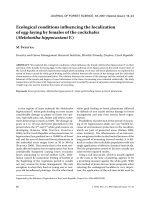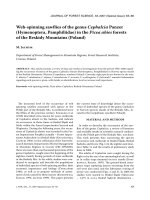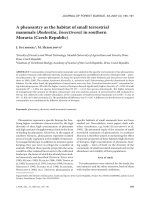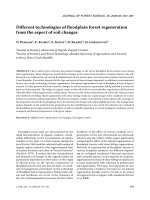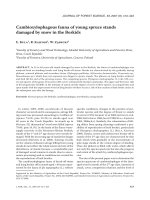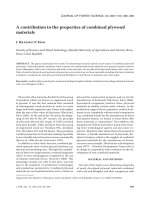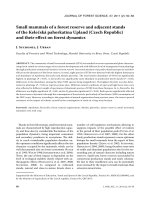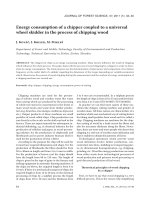Báo cáo lâm nghiệp: " Web-spinning sawflies of the genus Cephalcia Panzer (Hymenoptera, Pamphiliidae) in the Picea abies forests of the Beskidy Mountains (Poland)" pptx
Bạn đang xem bản rút gọn của tài liệu. Xem và tải ngay bản đầy đủ của tài liệu tại đây (598.59 KB, 6 trang )
J. FOR. SCI., 53, 2007 (Special Issue): 63–68 63
JOURNAL OF FOREST SCIENCE, 53, 2007 (Special Issue): 63–68
Web-spinning sawflies of the genus Cephalcia Panzer
(Hymenoptera, Pamphiliidae) in the Picea abies forests
of the Beskidy Mountains (Poland)
M. J
Department of Forest Management in Mountain Regions, Forest Research Institute,
Cracow, Poland
ABSTRACT: is article presents a review of data and results of investigations from the period 1958–2006 regard-
ing the occurrence of insects of the genus Cephalcia Panzer (Hymenoptera, Pamphiliidae) in Norway spruce stands
of the Beskidy Mountains (Western Carpathians, southern Poland). Currently, eight species are known for the area:
C. abietis, C. alashanica, C. alpina, C. annulicornis, C. arvensis, C. erythrogaster, C. fulva
and C. masuttii. Information
regarding each species is given, with details on identification, local occurrence and importance.
Keywords: web-spinning sawfly; Picea abies; Cephalcia; Beskidy Mountains; Poland
e increased level of the occurrence of web
spinning sawflies associated with spruce in the
Polish part of the Beskidy Mts. is mentioned since
the fifties of the previous century. K et al.
(1958) described a few, known for years, outbreaks
of Cephalcia abietis in the Sudetes, and indicate
its occurrence in those times in Beskid Śląski and
Mały, within the Forest Inspectorates Szczyrk and
Wapienica. During the following years, the occur-
rence of Cephalcia abietis was recorded in the For-
est Inspectorate Porąbka (actually – Forest Inspec-
torate Andrychów) in Beskid Mały (K,
C 1963). In the collections of the Forest Re-
search Institute, Department of Forest Management
in Mountain Regions in Cracow (FRI DFMMR),
there are more than one thousand specimens of the
genus Cephalcia, caught since the beginning of the
eighties, mainly during periods of mass outbreaks
in the Beskidy Mts. In the while, studies were con-
ducted to recognize and describe the populations
of individual species of web-spinning sawflies, their
economic importance and biology (Ć
1986), as well as to propose methods of assess-
ment of risk caused by these insects (K,
K 1995; J 1999). is paper presents
the current state of knowledge about the occur-
rence of individual species of the genus Cephalcia
in Norway spruces stands of the Beskidy Mts., lo-
cated in the Carpathians (southern Poland).
MATERIAL AND METHODS
In order to describe the occurrence of the saw-
flies of the genus Cephalcia, a review of literature
and available results of scientific research conduct-
ed in the Polish part of the Beskidy Mts. was done.
is work presents data concerning the species
occurrence and outbreaks in Beskid Śląski, Beskid
Sądecki, and Gorce (Fig. 1) in the eighties and nine-
ties (Table 1), and the results of preliminary study
done in 2006.
e adults of Cephalcia were caught during the
flight or by the use of an entomological net, as well
as in collar traps mounted on tree trunks (K-
, K 1995). e ground-based emer-
gence traps capturing insects swarming from the
soil were also used, and the laboratory rearing of
larvae was conducted (Figs. 2 and 3). In 2006 the
studies were started in Beskid Śląski (Skrzyczne
– 1,275 m a.s.l.), Beskid Sądecki (Radziejowa –
64 J. FOR. SCI., 53, 2007 (Special Issue): 63–68
1,262 m a.s.l.) as well as in the Gorce Mts. (Kudłoń
– 1,276 m a.s.l., Jaworzyna Kamienicka – 1,288 m
a.s.l. and Mostownica – 1,244 m a.s.l.). e study
plots were selected in Norway spruce stands on
the areas affected by former outbreaks from 1980s.
e collection of insects was conducted by collar
traps (grouped by three or four traps, two groups in
Skrzyczne, three groups in Gorce and two groups
in Radziejowa), placed on study plots, and using an
entomological net.
e species caught in Beskid Śląski, Beskid
Sądecki and the Gorce in the eighties and nineties,
which are available in the collection in Cracow,
were determined mainly by Tomasz Huflejt (Polish
Academy of Sciences, Zoology Museum and Insti-
tute, Warsaw) and sometimes by Leszek Ćwikliński
(FRI DFMMR). e species occurring more rarely,
like C. alashanica and C. masuttii, were also deter-
mined by Tomasz Huflejt. C. fulva and C. annuli-
cornis were labelled by the author, in cooperation
with Andrea Battisti (University of Padova, Italy).
RESULTS AND DISCUSSION
During the study in 2006, five species of Cephal-
cia were caught in the spruce stands in former out-
break areas (Table 2).
e mass occurrence of web-spinning sawflies
(C. abietis, C. alpina, C. arvensis ) in Beskid Śląski
and Beskid Żywiecki was recorded since 1976, as
described in details by D (1992, 1996) and
K and J (1998). In the Skrzy-
czne Mountain, C. alpina was often accompanied
by C. erythrogaster (D 1996).
Table 1. reat and control by Cephalcia spp. in Beskidy Mountains in 1976–1998 period
Years
Beskid Śląski Beskid Sądecki Gorce
threat species control threat species control threat species control
1976 75 C. abietis 0 0 0
1977 0 0 0 0
1978 79 C. abietis 0 0 0
1979 196 C. abietis 0 0 0
1980 76 C. abietis/alpina 0 175 C. alpina 0 1,092 C. alpina 0
1981 294 C. abietis/alpina 0 117 C. alpina 0 646 C. alpina 0
1982 382 C. abietis/alpina 421 131 C. alpina 0 1,150 C. alpina 0
1983 428 C. abietis/alpina 890 342 C. alpina 330 1,589 C. alpina 0
1984 181 C. abietis/alpina 1,042 296 C. alpina 430 1,368 C. alpina 0
1985 416 C. abietis/alpina 2,149 202 C. alpina 402 1,077 C. alpina 0
1986 349 C. abietis/alpina 1,245
1987 142 C. abietis/alpina 546
1988 79 C. abietis 307
1989 18 C. abietis 442
1990 737 C. abietis 1,522
1991 0 115
1992 29 C. abietis 155
1993 0 0
1994 245 C. abietis 545
1995 581 C. abietis 1,184
1996 12 C. abietis/alpina 147
1997 488 C. abietis/alpina 772
1998 1,009 C. abietis 741
1999 0 0
J. FOR. SCI., 53, 2007 (Special Issue): 63–68 65
e development of the C. alpina outbreak be-
tween 1976 and 1985 in Gorce Mts. (formerly – Li-
manowa and Krościenko Forest Inspectorates, cur-
rently the area of the Gorce National Park) was de-
scribed by C (1982) and H and H-
(1988). is work was done during the peak of
mass occurrence, previously not observed anywhere at
such a large scale. e occurrence of the same web-
spinning sawfly species during the same period
(1976–1984) in Beskid Sądecki (Radziejowa) was also
described by H (1984) and J (1985).
Due to weak taxonomic revision of the genus Ce-
phalcia and the inaccurate or erroneous descrip-
tions, the species C. fallenii was not distinguished
for a long time from C. lariciphila (Wachtl), and
both were mentioned from areas of Europe as
C. alpina
. B (1976) finally stated the autono-
my of these species, separated them and cleared the
terminology. In relation to the revision by B
(1976), who solved the taxonomic problem by find-
ing appropriate traits differentiating C. fallenii and
C. lariciphila, and treated the other connected
names of web-spinning sawflies as synonyms, the
name C. alpina was not indicated as a younger syn-
onym of C. abietis (as interpreted by B), but
as an older synonym of C. fallenii. Consequently,
the name C. alpina should become obligatory for
C. fallenii (B et al. 1998). In past Polish litera-
Table 2. Cephalcia specimens caught by entomological net and collar traps in 2006 and other Cephalcia found in the Beskidy
Mountains
No. Species name Beskid Sądecki Gorce Beskid Śląski
1 C. annulicornis (Hartig, 1837) 22 10 5
2 C. alpina (Klug, 1808) (= fallenii Dalman) 40 26 53
3 C. arvensis Panzer, 1805 54 5 7
4 C. abietis (Linné, 1758) 2
5 C. erythrogaster (Hartig, 1837) 1 2 2
6 C. alashanica Gussakovskij, 1935 C et al. (1997)
7 C. fulva Battisti & Zanocco, 1994 S and Z (2003)
8 C. masuttii Battisti & Boato, 1998 J et al. (2005)
Fig. 1. Range of the area of interest. Occurrence and outbreaks in Beskid Śląski, Sądecki, and Gorce in the eighties and
nineties
66 J. FOR. SCI., 53, 2007 (Special Issue): 63–68
ture, however, C. alpina was treated as C. fallenii
and thus all former publications related to C. falle-
nii have to be considered valid for the species now-
adays called C. alpina.
e observations done during the strong swarm-
ing of adults, that occurred in the Skrzyczne mas-
sif in the eighties, indicated the probability of the
occurrence of several C. alpina types (Ć
1986, 2000). e detailed studies allowing the sepa-
ration of two species were conducted in 1990–1995
in Italy (B et al. 1998). e material for their
studies on species biology were obtained from the
Czech Republic, Poland, and Italy. e results al-
lowed to separate populations between two species
formerly known from literature and called C. alpi-
na and C. annulicornis.
e analysis of entomological materials from the
mass occurrence areas of C. alpina (Beskid Śląski
– 1976–1984, Gorce – 1978–1985, Beskid Sądecki
– 1976–1984, Sudeten – 1982–1984, Gdańsk
– 1993–1996), done by Italian scientists showed
that a high percentage (up to 90%) of web spinning
sawflies labelled as C. alpina showed morphologi-
cal traits of C. annulicornis. Both species occurred
together within outbreak areas, but their propor-
tions varied drastically among locations, with no
clear relationships to environmental factors, forest
characteristics (type of stand, altitude), and local
climate.
C. alashanica is known from Beskid Śląski. A
few specimens were caught in Skrzyczne Moun-
tain already in the eighties, they were placed in col-
lections of FRI DFMMR in Cracow (C et al.
1997). A specimen from the same area from 1985
Fig. 2. Ground-based emergence trap capturing insects
swarming from the ground (photo M. Kosibowicz)
Fig. 3. Collar trap mounted on tree trunks (photo M. Kosi-
bowicz)
was also found in the Hymenoptera Collection of
the Hungarian Natural History Museum in Buda-
pest (S, Z 2003). Some species
of C. alashanica from the collection in Cracow
have been relabelled as C. masuttii (J et al.
2005).
C. fulva was also described from Beskid Śląski,
based on a specimen caught in 1985 (S,
Z 2003) and repeatedly in spruce stands
near Skrzyczne Mountain in 2004. A pair, male and
female, was placed in the collections of FRI DFMMR
in Cracow (Table 2).
T et al. (2006) mentioned 7 species of the
8 that occur in Poland: C. abietis, C. alashanica,
C. alpina, C. annulicornis, C. arvensis, C. erythro-
gaster and C. fulva, but C. masuttii was not indi-
cated there. C et al. (1997) reported 5 spe-
cies on spruce in Beskidy Mts. forests: C. abietis,
C. alashanica, C. alpina, C. arvensis, C. erythro
-
gaster; this author indicated also the occurrence of
C. pallidula in north eastern Poland.
As considerable variation was observed among
specimens, more research and new genetic meth-
ods of work will allow to improve knowledge about
this genus and possibly help to recognize new spe-
cies.
Acknowledgements
e author sincerely thanks Dr. A B-
for making possible the visit to Padova Uni-
versity, for the access to their collections and or
help with determination of insects of the Cephalcia
genus.
J. FOR. SCI., 53, 2007 (Special Issue): 63–68 67
Ploskohřbetky rodu Cephalcia Panzer (Hymenoptera, Pamphiliidae)
v porostech smrku ztepilého v Beskydech (Polsko)
ABSTRAKT: Článek prezentuje zhodnocení dat a výsledků výzkumů z období 1958–2006, týkajících se výskytu
hmyzu rodu Cephalcia Panzer (Hymenoptera, Pamphiliidae) na smrkových stanovištích v Beskydech (západní
Karpaty, jižní Polsko). Aktuálně je z této oblasti známo osm druhů:
C. abietis, C. alashanica, C. alpina, C. annuli-
R e f e r e n c e s
BATTISTI A., BOATO A., ZANOCCO D., 1998. Two sibling
species of the spruce web-spinning sawfly Cephalcia fal-
lenii (Hymenoptera, Pamphiliidae) in Europe. Systematic
Entomology, 23: 99–108.
BENEŠ K., 1976. Revision of the European species of Ce-
phalcia Panzer, 1805 (Hymenoptera, Pamphiliidae). Studie
ČSAV. Praha, Academia, 3: 1–68.
BLANK S.M., SHINOHARA A., TAEGER A., 1998. Revision-
ary notes on Pamphiliid sawflies. Mitteilungen Museum
Naturkunde Berlin. Deutsche Entomologische Zeitschrift,
45: 17–31.
CAPECKI Z., 1982. Masowe wystąpienie zasnui wysokogór-
skiej – Cephalcia fallenii (DALM) (Pamphiliidae, Hy-
menoptera) w Gorcach. Sylwan, No. 126: 41–50.
CELARY W., CZECHOWSKI W., CZECHOWSKA W., DY-
LEWSKA M., GARBARCZYK H., HUFLEJT T., MALCHER
M., PALACZYK A., WIŚNIOWSKI B., 1997. Hymenoptera.
In: RAZOWSKI J. (ed.), Checklist of animals of Poland.
Cracow, Institute of Systematics and Evolution of Animals
Polish Academy of Sciences, 5: 7–160.
ĆWIKLIŃSKI L., 1986. Zbadanie biologii, znaczenia gospo-
darczego i możliwości przeciwdziałania występowaniu
osnujki (Cephalcia) w górskich drzewostanach świerkowych.
[Manuscript.] Cracow, Forest Research Institute, Depart-
ment of Forest Management in Mountain Regions: 94.
ĆWIKLIŃSKI L., 2000. Tajemnica “blondynki” czyli o zasnui
śląskiej. Las Polski, 6: 32–33.
DUDIK W., 1992. Zasnuje – groźne szkodniki pierwotne
świerka. Trybuna Leśnika, 5: 8–9.
DUDIK W., 1996. Masowe pojawy zasnuj (Cephalcia sp.) na
terenie RDLP Katowice w latach 1976–1995. Prace Instytutu
Badawczego Leśnictwa, Seria B, 28: 53–57.
HONOWSKI J., HUFLEJT T., 1988. O występowaniu zasnui
wysokogórskiej, Cephalcia fallenii (Dalm.) (Hymenoptera,
Pamphiliidae) w Gorczańskim Parku Narodowym. Polskie
Pismo Entomologiczne, 58: 433–446.
HUFLEJT T., 1984. Zagrożenie drzewostanów świerkowych
przez ważniejsze rośliniarki. Prace Instytutu Badawczego
Leśnictwa, Seria B, 1: 41–56.
JACHYM M., 1999. Forecast and control of the spruce web-
spinning sawflies (Cephalcia sp.) in the Beskidy Mountains
in Poland in 1998. In: FORSTER B., KNÍŽEK M., GRODZKI
W. (eds), Methodology of Forest Insect and Disease Survey
in Central Europe. Proceedings of the Second Workshop
of the IUFRO WP 7.03.10. April 20–23, Sion-Châteauneuf,
Switzerland: 164–167.
JACHYM M., LIŠKA J., HOLUŠA J., 2005. First record of
Cephalcia masuttii (Hymenoptera: Pamphiliidae) in Po-
land and the Czech Republic. Entomological Problems,
35: 113–114.
JASICA T., 1985. Zasnuja wysokogórska w Beskidzie Sądec-
kim. Las Polski, 5: 9–10.
KAPUŚCIŃSKI S., CAPECKI Z., 1963. Prognoza występowa-
nia szkodliwych owadów leśnych w roku 1963 w lasach po-
łudniowej Polski na terenie Okręgowych Zarządów Lasów
Państwowych: Kieleckiego, Rzeszowskiego, Krakowskiego,
Katowickiego, Opolskiego i Wrocławskiego. [Manuscript.]
Cracow, Forest Research Institute: 17.
KOEHLER W., SCHNAIDER Z., ŚLIWA E., 1958. Prognoza
występowania szkodliwych owadów leśnych w 1958 r.
Sylwan, No. 5/6: 149–171.
KOSIBOWICZ M., JACHYM M., 1998. e spruce web-spin-
ning sawflies (Cephalcia sp.) in the Beskidy Mountains in
Poland – occurrence, importance and control. In: GRODZ-
KI W., KNÍŽEK M., FORSTER B. (eds), Methodology of
Forest Insect and Disease Survey in Central Europe. Pro-
ceedings of the First Workshop of the IUFRO WP 7.03.10.
April 21–24, Ustroń-Jaszowiec, Poland: 85–87.
KOSIBOWICZ M., KOZIOŁ M., 1995. Możliwości wyko-
rzystania pułapek kołnierzowych w badaniach bioindy-
kacyjnych i monitoringu zagrożenia lasów. Sylwan, No.
5: 31–40.
SHINOHARA A., ZOMBORI L., 2003. Records of Pamphiliid
sawflies (Hymenoptera) from the Ukrainian Carpathians,
Poland and western Russia. Folia Entomologica Hungarica,
64: 223–226.
TAEGER A., BLANK S.M., LISTON A.D., 2006. European
sawflies (Hymenoptera: Symphyta): a species checklist for
the countries. In: BLANK S.M., SCHMIDT S., TAEGER
A. (eds), Recent Sawfly Research: Synthesis and Prospects.
Keltern, Goecke & Evers: 399–504.
68 J. FOR. SCI., 53, 2007 (Special Issue): 63–68
cornis, C. arvensis, C. erythrogaster, C. fulva a C. masuttii. Předkládají se informace o všech těchto druzích s detaily
o identifikaci, lokálním výskytu a významu.
Klíčová slova: ploskohřbetky; Picea abies; Cephalcia; Beskydy; Polsko
Corresponding author:
Dr. M J, Forest Research Institute, Department of Forest Management in Mountain Regions,
Ul. Fredry 39, 30 605 Cracow, Poland
tel.: + 48 122 528 205, fax: + 48 122 528 202, e-mail:
